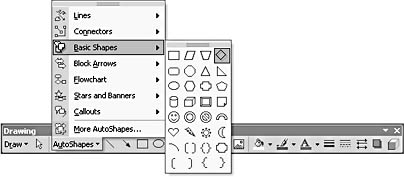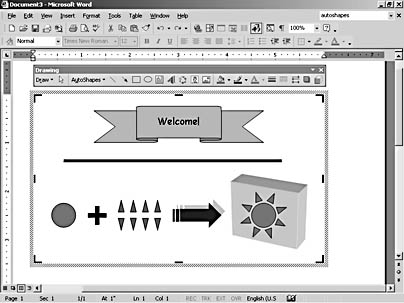Getting Acquainted with Drawing Features in Word
3 4
Semantically, it might sound a little odd that you can draw in Word, but drawing capabilities have been steadily evolving in Word throughout the last few versions. As an experienced Word user, you're probably familiar with the basic drawing tasks you can perform in Word, such as creating lines and inserting shapes. In Word 2002, the drawing capabilities continue to grow with the addition of an optional drawing canvas, which can help you to further control how drawings are displayed in your documents. (The drawing canvas is discussed in more detail in the section "Understanding the Role of the Drawing Canvas,") As you know, Word is a document creation program, not a painting program, so you should expect some drawing limitations in Word, and you should count on creating detailed graphics in a true painting program. On the other hand, the Word drawing tools are advanced enough to be extremely handy when you want to create particular types of drawings, including the following:
- Arrows or connection lines
- Simple iconlike illustrations
- Bare-bones office or room layout illustrations
- Diagrams, flowcharts, and organizational charts (See Chapter 20, "Diagramming Projects, Process, and Relationships.")
- Images created by combining regular shapes, such as squares, ovals, and lines
- Splash starbursts and shapes containing text blocks
- Stylized WordArt text (See Chapter 17, "Customizing Documents with WordArt.")
You can access the tools required to create drawing objects by using the Drawing toolbar and the AutoShapes drop-down menu (which is on the Drawing toolbar). In addition, you can effectively control your drawings by mastering the relationship between drawing objects and the drawing canvas.
Familiarizing Yourself with the Drawing Toolbar and the AutoShapes Drop-Down Menu
When you create drawings in Word, you must work with the Drawing toolbar, which provides a central location for drawing tools. To display the Drawing toolbar, click the Drawing button on the Standard toolbar, or choose View, Toolbars, Drawing. Table 16-1 describes the buttons available on the Drawing toolbar.
Table 16-1. Drawing Toolbar Buttons
| Button | Name | Function |
|---|---|---|
| Draw | Provides a drop-down menu with drawing and editing commands, such as Order, Group, and Text Wrapping |
| Select Objects | Enables you to select one or more drawing objects |
| AutoShapes | Provides ready-made shapes, including lines, basic shapes, arrows, stars, banners, callouts, and others |
| Line | Enables you to click and drag to draw a line |
| Arrow | Enables you to click and drag to draw an arrow |
| Rectangle | Enables you to click and drag to create a square or a rectangle |
| Oval | Enables you to click and drag to draw a circle or an oval |
| Text Box | Enables you to create a text box so that you can add text to drawing objects |
| WordArt | Opens the WordArt Gallery |
| Diagram | Opens the Diagram Gallery |
| Clip Art | Opens the Insert Clip Art task pane in the current view |
| Picture | Opens the Insert Picture dialog box |
| Fill Color | Enables you to control the color, texture, pattern, or picture used to fill drawing objects |
| Line Color | Enables you to control the color, texture, pattern, and effect of line objects |
| Font Color | Enables you to color text |
| Line Style | Provides a variety of line styles and settings you can apply to lines and borders |
| Dash Style | Provides a variety of dashed line styles and settings you can apply to lines and borders |
| Arrow Style | Provides a variety of arrow styles and settings you can apply to lines |
| Shadow Style | Enables you to add and control shadow effects for drawing objects |
| 3-D Style | Enables you to add and control 3-D settings for drawing objects |
| Select Multiple Objects | Opens the Select Multiple Objects dialog box; not shown by default |
In addition to using Drawing toolbar buttons to draw shapes, you can insert standard shapes into your documents by using the AutoShapes drop-down menu, which is accessed by clicking AutoShapes on the Drawing toolbar, as shown in Figure 16-1. The AutoShapes drop-down menu provides a library of shapes that you can use to create custom drawings. After you insert an AutoShape, you can color, resize, reshape, and otherwise customize the object, as you'll see throughout this chapter. You can also combine AutoShapes and other drawing components to create more complex graphics.

Figure 16-1. The AutoShapes drop-down menu provides a collection of shapes you can insert and combine to create custom graphics.
Understanding the Role of the Drawing Canvas
Before you create a drawing using the Word drawing tools, you should understand how drawings work in Word 2002. By default, when you create a drawing in Word, the drawing is placed on a drawing canvas. You don't have to use the drawing canvas when you create drawings, but you will probably find it useful. After all, the drawing canvas is designed to help you control drawing objects combined to create a single drawing as well as control how completed drawings are displayed within your document.
To display a new drawing canvas, perform one of the following actions:
- Choose Insert, Picture, New Drawing.
- On the Drawing toolbar, choose an AutoShape on the AutoShapes drop-down menu.
- On the Drawing toolbar, click the Line, Arrow, Rectangle, Oval, or Text Box button.
Figure 16-2 shows a couple of objects placed on an active drawing canvas.
Notice that the drawing canvas displays a framelike boundary while you work. The frame outlines the drawing canvas's current working area, and it includes solid black lines and corners that you can drag to resize the canvas. By default, the drawing canvas doesn't have borders or background formatting, but you can customize the drawing canvas just as you can customize any other drawing object. For example, you can add color, apply shading, resize the frame, add 3-D effects, and so forth. To access formatting options for the drawing canvas, you can right-click the drawing canvas and choose Format Drawing Canvas on the shortcut menu, double-click a blank area of the drawing canvas, or click in the drawing canvas and choose Format, Drawing Canvas. Each of these techniques opens the Format Drawing Canvas dialog box, which is discussed in more detail in the section, "Integrating the Drawing Canvas with Document Text."

Figure 16-2. The drawing canvas helps you control drawing objects relative to other drawing objects in a drawing and control the overall relationship between the complete drawing and the document's contents.
If you prefer that the drawing canvas not appear by default each time you insert a drawing object, you can change this setting. To do so, follow these steps:
- Choose Tools, Options, and click the General tab.
- Clear the Automatically Create Drawing Canvas When Inserting AutoShapes check box, and click OK.
Keep in mind that the drawing canvas is highly customizable and helps you to easily move combined drawing objects as a unit. For the most part, you'll probably want to use the drawing canvas when you create drawings unless you're inserting a single object, such as a line or an arrow.
Tip - Delete a drawing canvas without deleting a drawing
If you create a drawing on a drawing canvas and later decide that you don't want to use the drawing canvas, you can drag your drawing off the drawing canvas, select the drawing canvas, and then press Delete (or right-click the drawing canvas and choose Cut on the shortcut menu). This action enables you to retain your drawing while deleting the drawing canvas.
EAN: 2147483647
Pages: 337




















